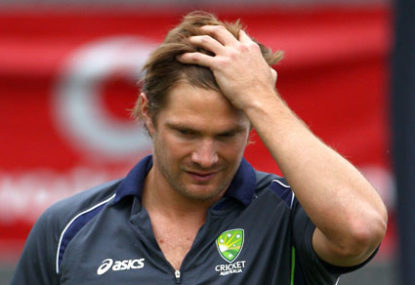“Your strategy for victories in battle is not repetitious, and your formations in response to the enemy are endless.” – Sun Tzu, The Art of War
Australia can convert its biggest weakness into a strength by bucking 100 years of convention, and embracing a malleable top six.
Debate has raged over the make-up of the Australian batting order throughout 2013, from the shambles that was the tour of India, dominating the lead-up talk to the Ashes, and subject to constant change during it.
After the disgraceful collapse that occurred on Sunday night in the fourth Test, calls for mass sackings were as loud as they were predictable.
It’s time for people to realise there is no set of magic batsmen out there who have been missed. Instead, we have to make do with what we’ve got.
There are plenty of questions about our batsmen, and each one divides opinion.
Should Shane Watson open, as he wants to, or bat at six to protect his body from the strain of too much all-rounders load?
Should David Warner bat at six and be a destructive presence against the old ball, or open to set the tone?
Should Usman Khawaja come in at three, or be allowed to settle down the order while he finds his feet at Test level?
Michael Clarke should bat at three, four or five depending on who you listen to.
Phil Hughes either can’t play spin so has to open, or doesn’t have the technique for the quicks, so is better suited in the middle order.
Steve Smith should bat at four to save Clarke for his favourite position, or is at his best counter-attacking at five or six.
All of the above should be an option when Australia is at the crease. Versatility is seen as an important factor in any work place, so why not for a batsman in the Australian cricket team?
In an ideal world, like the one the England Test team currently resides in, a concrete top six is a luxury not to be thought twice about.
But the Australian Test side doesn’t exist in that world. In fact, it’s so far away as to be Pluto to England’s Earth.
We are at war with the Poms, and we’re losing battle after battle, badly so.
When an underdog is outmatched in terms of talent, it must resort to other means to level the playing field.
So why not embrace the chaos? A captain doesn’t call on his bowlers at a fixed time every innings, and Michael Clarke, especially, has shown an ability to make a change based on game situation.
The same should apply to the batting order.
Much has been made of the meticulous planning undergone by the England hierarchy, and Alastair Cook has often been accused of captaining by the numbers, especially in the field.
Meeting such structured thinking with a rigid game-plan is destined to fail without feats of individual brilliance.
Michael Clarke is the best batsman in the side, but is also more vulnerable than most to the moving ball early in an innings.
While he shouldn’t be out there at 1/10 or when the ball is still new, there’s no reason he shouldn’t be the next one to the crease after a century opening stand.
Maybe if he had have come out at three instead of Khawaja on Sunday, he’d be celebrating a comfortable victory right now, rather than painfully looking for yet more excuses.
Shane Watson, at his best with the field up, can be moved up or down depending on the game situation.
If Graeme Swann is looking particularly dangerous, Steve Smith or Brad Haddin can be called into the fray earlier than they otherwise might.
The Aussie top six consists of three left-handed batsmen, and three right. Why not have one of each padded up at all times, to go in depending on who falls, and keep opposites at the crease, not allowing the bowlers to settle in a groove?
We always hear plenty about how batsmen like to prepare a certain way based on the position they’re batting, but such talk is nonsensical. When you actually think about it, it’s simply ludicrous.
On the first day of a Test match, a number three can be in for the second ball, or the second over after tea. Batting at five could see you walk to the crease at 3/40 before drinks have been taken, or 3/270 with two overs to go in the day.
You can’t have two blokes padded up to be in depending on which scenario unfolds? A Test match batsman is going to go to water because he can only bat when three wickets have fallen rather than two? Give me a spell.
The batting order should adapt to the match depending on how best to apply the skills within.
It’s currently seen as a weakness to not have a settled batting order. Let’s make it a strength.
The motto of the Australian batsmen should be a battle-cry: “Anywhere. Anytime.”





























































































